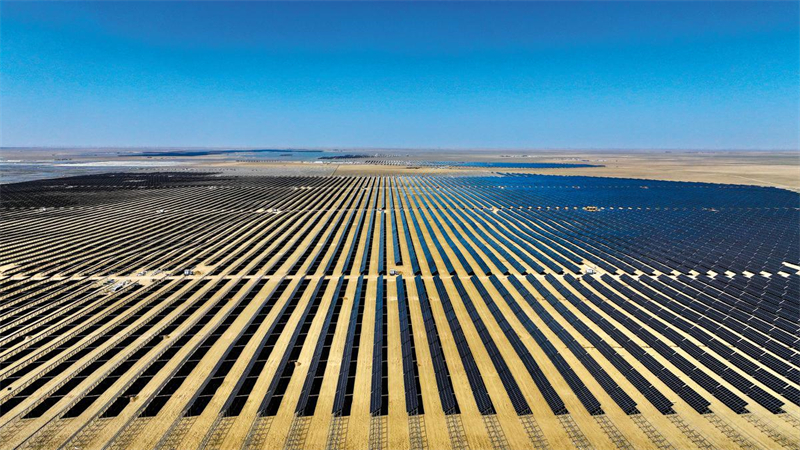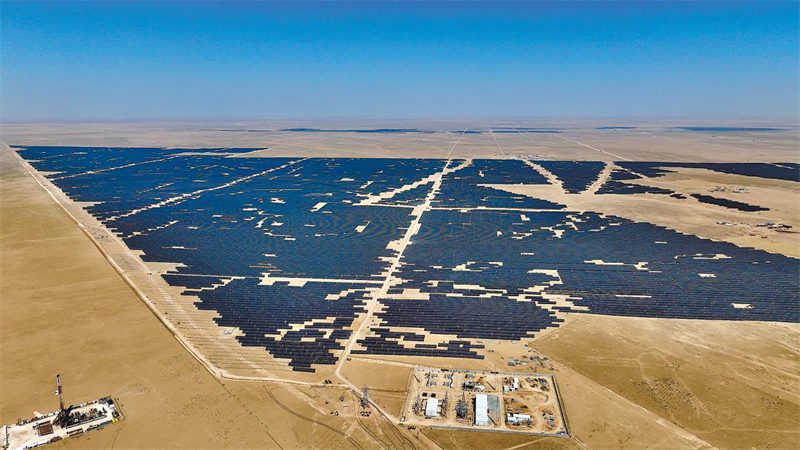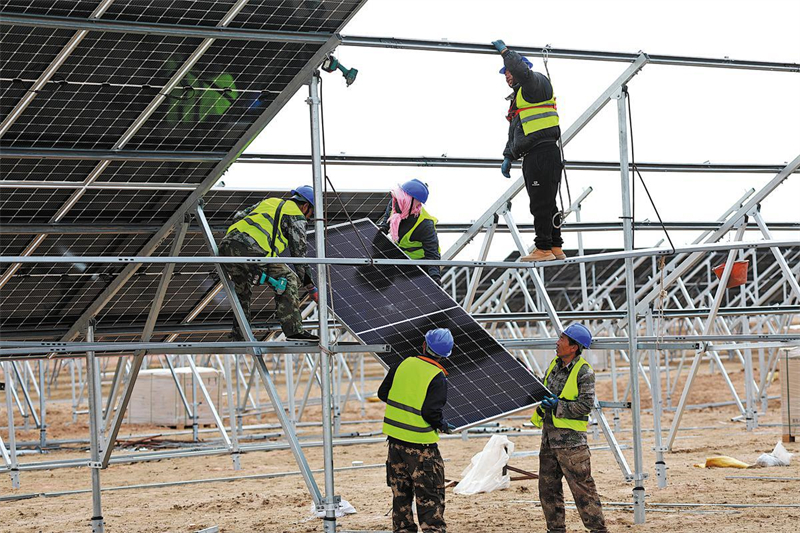Solar power project soaks up sunrays in Inner Mongolia

An array of photovoltaic panels in Otog Front Banner, Inner Mongolia autonomous region. CHINA DAILY
Under an intense azure sky, the relentless sunrays scorch without mercy. Sweat pours only to evaporate in an instant. Despite crawling along, vehicles are followed by a long tail of dust kicked up from unpaved roads.
Welcome to Otog Front Banner in the Inner Mongolia autonomous region, a 12,200 square-kilometer county-level area where evaporation outweighs precipitation.
Sand control has always been a key task for the banner, located close to the Mu Us Desert, the fifth largest desert in China. The county, despite having rich coal reserves, is confronted with the increasingly urgent task of promoting the low-carbon transition.
The arid conditions and abundant sunshine make Otog a perfect location for tapping the potential of synergizing sand control and solar energy.
Compared with the vast land under the jurisdiction of Otog, the Mengxi Otog Front Banner Photovoltaic Base project, which covers about 7,000 hectares, is much like a tiny grain of sand on the beach. But the scale of the ongoing project launched there in October last year is about the size of 10,000 standard soccer pitches.
Under the scorching sun, workers are racing against the clock to ensure that they can complete the 3 million-kilowatt project before the end of September. At its peak, there are 4,000 people working on the construction site in Shanghaimiao township, according to GD Power Development Co, the project's developer.

The Mengxi Otog Front Banner Photovoltaic Base project is located near the Mu Us Desert. CHINA DAILY
Most of the laborers take with them colossal flasks of water when they start work in the morning so that they can ensure their bodies stay hydrated throughout the day.
Despite being a veteran solar panel installer, Chen Zhongliang still finds it challenging to work in such arid conditions.
The consistent and rapid solar energy development in China has seen the man from Hengshui, Hebei province, travel to most provincial regions around the country to install solar panels over the past decade.
Work has been so busy that Chen can only spare time to go back to his hometown each year during the Spring Festival holiday, the most important occasion for family reunions in China, he said.
He added, however, it was the first time for him to work in Inner Mongolia. Despite having been working on the project for over half a year, he still can't get used to the local climate.
"It's too dry," he said, adding he needs to drink water frequently to prevent him from suffering dehydration and sunstroke.
Chen usually works with five others on installation. The team can install 26 solar panels on a single frame in 20 to 30 minutes.
According to GD Power Development Co, the number of solar panels to be installed in the project totals roughly 6.4 million. Meanwhile, 2.35 million steel piles have to be driven into the ground as foundations to support the frames.
Li Jinyuan, manager of the Mengxi Otog project, said the sweat-inducing efforts of workers are going to lead to substantial environmental and economic benefits.
After going into operation, it is expected to generate 5.7 billion kilowatt-hours of electricity a year, which based on the country's per capita electricity consumption last year, can meet the electricity needs of 30,000 households, he said.
It can reduce the use of standard coal by 1.71 million metric tons annually, and reduce carbon dioxide emissions by approximately 4.7 million tons, he added.
Full use will be made of the spaces underneath the solar panels after the installation work is completed, Li said, adding the area will be used for rearing sheep and growing low-lying commercial crops such as matrimony vine and alfalfa. It's hoped this will further inject economic momentum into rural vitalization in the area.
Traditionally, concrete piles with a diameter of 40 centimeters would be used to build the foundations for the solar frames. However, the company is instead using steel piles with a diameter of only 10 cm, significantly reducing the damage to the already sparse grass on the desertified land, he said.

Workers install photovoltaic panels. CHINA DAILY
Huang Weiheng, an executive on the project, said while solar panels can provide shade on desertified land and thus reduce evaporation, and robots will be used to regularly clean the panels with water, which will moisten the parched land to some extent and help limit the spread of desertification.
While it's yet to be known if the project will successfully remediate the desertified land, some positive changes have already come about.
In areas that are already covered by solar panels, "I have noticed obvious increases in vegetation coverage", Huang said.
Gongor, a 45-year-old herdsman who lives near the solar energy project, said he's found that the grass has become more lush and has grown more vigorously after the launch of the project.
"I believe I can make more money from my 6,000-odd sheep because of these changes," the man of the Mongolian ethnic group said.
The project is just a small part of the ambitious plan of the Inner Mongolia government to integrate sand control with renewable energy to tame the ever-expanding desertified area, said Sun Shaocheng, the region's Party secretary.
Along with other initiatives, the project helps push forward the Three-North Shelterbelt Forest Program in the region, Sun said in an interview with China Daily.
Launched in 1978, the Three-North program spans 13 provincial regions, with Inner Mongolia a major battleground. It aims to improve the environmental conditions in northern China and prevent the expansion of deserts.
Sun said the region plans to achieve an installed capacity of 119 million kW of renewable energy by the end of this decade, and that it would help treat around 767,300 hectares of desertified land.
The official vowed to better coordinate new energy development and sand control by accelerating the construction of centralized solar power plants and grid facilities in deserts and wastelands, and also by promoting the development of distributed solar and wind energy in other desertified areas based on local conditions.
He said the region will strive to tap the potential of the land underneath solar panels for planting, and the spaces between the panels for animal husbandry, so as to create a "win-win" situation of increasing greenery, energy output and local incomes.
Zhang Jingbo, deputy director of the Experimental Center of Desert Forestry at the Chinese Academy of Forestry, said integrating sand control and solar energy development can help address the contradictions between development and ecological conservation.
The approach not only involves industrial development but also the remediation of desertified land and the industrialization of ecological conservation, he said. Aside from enhancing sand control and vegetation restoration, it can help bring enterprises profitability, increase farmers' and herders' incomes and realize harmony between conserving nature and socioeconomic development.
In the long run, however, such endeavors still need more scientific support and innovation to further improve the approach, he added.
Zhang underscored the importance of developing tailored models based on local conditions, taking into account the climate, soil, water availability and vegetation coverage.
In accordance with these conditions, project developers should optimize the design of photovoltaic components and their layouts to enhance their capabilities in resisting wind and fixing sand, he noted.
To reduce costs and ensure the best treatment results, they should also lay sand barriers, plant vegetation and take measures to improve the soil, Zhang added.
Not far from the Otog project, the high-rise chimneys of a 4-million-kilowatt coal-fired power plant can be seen.
While it won't be easy for Otog, where over 21 million tons of coal is produced annually, to be free of coal-fired power soon, the green energy project will help significantly increase the proportion of renewables in the electricity mix it outputs to other regions via the State grid.
The coal-fired facility will help address the intermittence of solar energy production and thus ensure stable electricity output from the area. "When there is strong sunshine during the day time, that coal-fired plant will greatly reduce the electricity it produces," Zhang said.



 Print
Print Mail
Mail


